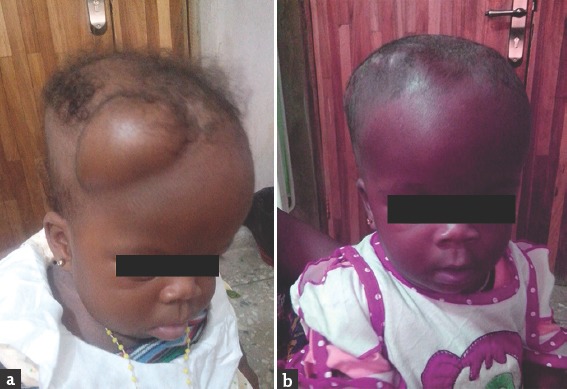Management and Outcome of Infantile Hydrocephalus
Hydrocephalus:
Hydrocephalus is a condition in which an accumulation of cerebrospinal fluid (CSF) occurs within the brain. This typically causes increased pressure inside the skull. Hydrocephalus can occur due to birth defects or be acquired later in life. Associated birth defects include neural tube defects and those that result in aqueductal stenosis. Other causes include meningitis, brain tumors, traumatic brain injury, intraventricular hemorrhage, and subarachnoid hemorrhage. The four types of hydrocephalus are communicating, noncommunicating, ex vacuo, and normal pressure.
Background:
Hydrocephalus is a leading cause of disability among children worldwide. The outcome depends on morphology and whether insult is pre- or post-natal. There has been improvement in morbidity in developed countries due to improved surgical care. A paucity of trained personnel impacts negatively on care and outcome of infants with hydrocephalus in many low-income countries resulting poorer outcome. Their conducted an audit of patients with hydrocephalus managed in their institution to determine common etiology and outcome.
Hydrocephalus is the most common condition treated by pediatric neurosurgeons. Ventriculoperitoneal shunt (VPS) remains the most common treatment for hydrocephalus world over even though it is associated with several short- and long-term complications. As shunt system continues to evolve over the years to improve the outcome of the procedure; surgeons have also devised other alternative and safer techniques for the treatment of hydrocephalus. The advent of endoscopes ushered in the endoscopic third ventriculostomy (ETV) technique and later endoscopic choroid plexus cauterization (CPC) as alternatives to shunting for hydrocephalus in 1995. Even then, there had been reported low success rate when used alone in some patients. Hence, the recent popularization of combined ETV + CPC technique as a relatively safe means of increasing the overall treatment outcome success and avoiding the need for a shunt in infants with hydrocephalus.
Despite of the recent advances in technology, VPS remains the most widely performed procedure for hydrocephalus in infants. Various shunt valve designed have been developed to improve the success rate of shunting for hydrocephalus. The general trends in developed country are the use of programmable shunt valves. In low-income country like Nigeria, however, low cost, fixed pressure shunt valve system is widely used.
This study was undertaken as an audit of infant hydrocephalus management in their institutions where fixed-pressure slit-in spring Chhabra ventriculoperitoneal shunt device is traditionally used.
Materials and Methods
This study included infants (<12 months) with hydrocephalus managed in their neurosurgical division over 3 years. Their institution has a facility for transcranial ultrasound, computed tomographic scan, and magnetic resonant imaging machines. The diagnosis of hydrocephalus was based on clinical and neuroradiologic evaluations. Data were collected retrospectively through review of case files, imaging reports, ward records, operative notes, and follow-up clinic charts. Information on demography, etiology, type and onset of hydrocephalus, treatment offered, complication, and outcome of care were retrieved using a predesigned pro forma. The main outcome measures were developmental milestones attained for age, complications, and death. Data were entered into 2011 IBM SPSS (Statistical Package for social sciences) software for windows, version 20; Armonk, NY (IBM Inc.).
Results
Fifty-eight infants constituting 76% of a total of 76 patients with hydrocephalus were treated between 2012 and 2014. Case files of these infants were retrospectively studied. There were 33 males (57%) and 25 females (43%) with male to female ratio of 1.3:1. Age of patient ranged between 3 and 12 months with a median age of 3 months (±standard deviation of 4.2 ± 2 months). The most common age group in this study was 1–6 months 33 (57%), while the 7–12 months age group had the least frequency 9 (15%)
A large proportion had an undetermined cause of their hydrocephalus 18 (31%). Of those with an identifiable congenital cause, the majority was due to Chiari II malformation 14 (24%) while intraventricular hemorrhage (IVH) was the most common acquired cause 10 (17%). In general, congenital hydrocephalus was more common 40 (69%) than acquired type 18 (31%) [Figures 1-3].

Neglected congenital hydrocephalus

Typical hydrocephalus
The majority of the patients 27 (47%) had communicating hydrocephalus, whereas noncommunicating type was seen in 17 (29%). VPS was the neurosurgical treatment offered in most of the cases 53 (91%), followed by 3 (3.4%) ETV, and 2 (1.7%) ventriculosubgaleal (VSG) shunt [Figure 3], respectively.

Infection was found to be the most common postoperative complication 7 (12%) in this series, followed by distal obstruction 5 (8.6%) while migration of shunt was the least complication experienced by patients 1 (1.7%). There were 2 perioperative deaths giving a mortality rate of 3.4%. One of the deaths was due to respiratory arrest in an infant with Chiari II malformation while the other patient was a preterm with IVH. The actual cause of death was not documented in the preterm. As at last follow up, most patients 38 (65.5%) were assessed has having satisfactory outcome based on developmental milestones attained for age.
Author information
Department of Surgery, College of Health Sciences, University of Ilorin, University of Ilorin Teaching Hospital, Ilorin, Kwara State, Nigeria1Department of Otorhinolaryngology, College of Health Sciences, University of Ilorin, University of Ilorin Teaching Hospital, Ilorin, Kwara State, Nigeria
Address for correspondence: Dr. Habeeb Kayodele Omokanye, Department of Otorhinolaryngology, College of Health Sciences, University of Ilorin/University of Ilorin Teaching Hospital, PMB 1459, Ilorin 240001, Kwara State, Nigeria.
Copyright
Copyright : © 2017 Journal of Neurosciences in Rural Practice